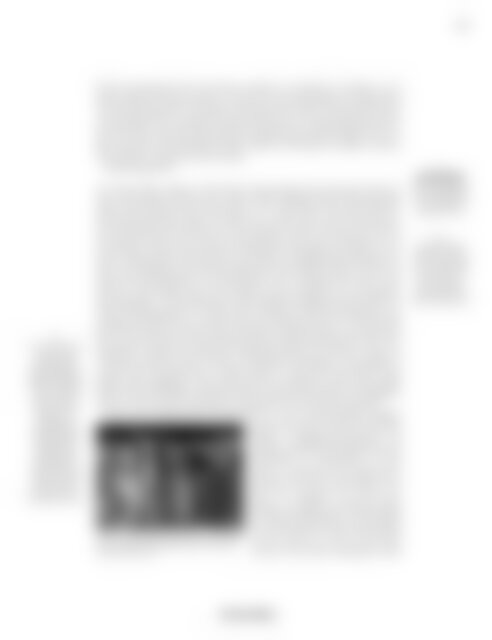Create successful ePaper yourself
Turn your PDF publications into a flip-book with our unique Google optimized e-Paper software.
145<br />
03<br />
On this, see LIFE from<br />
10 May 1945 and<br />
Margaret Bourke-<br />
White, “Dear Fatherland<br />
Rest Quietly”: A<br />
Report on the Collapse<br />
<strong>of</strong> Hitler’s “Thousand<br />
Years,” New York:<br />
Simon and Schuster,<br />
1946, figs. 53–68;<br />
Dagmar Barnouw,<br />
Ansichten von<br />
Deutschland (1945):<br />
Krieg und Gewalt in<br />
zeitgenössischer<br />
Fotografie, Basel/<br />
Frankfurt am Main:<br />
Stroemfeld/Nexus,<br />
1997, p. 163–201; and<br />
Norbert Frei, 1945:<br />
Ikonen eines Jahres,<br />
Munich: Schirmer<br />
Mosel, 2015, p. 115–117.<br />
“[I]f the photograph then becomes horrible, it is because it certifies, so to<br />
speak, that the corpse is alive, as corpse: it is the living image <strong>of</strong> a dead thing.<br />
For the photograph‘s immobility is somehow the result <strong>of</strong> a perverse confusion<br />
between two concepts: the Real and the Live: by attesting that the object<br />
has been real, the photograph surreptitiously induces belief that it is<br />
alive, because <strong>of</strong> that delusion which makes us attribute to Reality an absolute<br />
superior, somehow eternal value.”<br />
Roland Barthes 01<br />
<strong>The</strong> iconic image by Margaret Bourke-White first appeared on<br />
26 December 1960 in TIME magazine under the title Grim<br />
Greeting at Buchenwald.<br />
On 4 April 1945, soldiers <strong>of</strong> the Third United States Army arrived at the Ohrdruf<br />
concentration camp near Gotha; it was a satellite camp <strong>of</strong> Buchenwald,<br />
which they liberated a few days later, on 11 April 1945. <strong>The</strong> main camp on<br />
the Ettersberg near Weimar, in which there were still around 21,000 prisoners<br />
at that time, 02 was the first concentration camp to be freed by one <strong>of</strong><br />
the Western Allied forces without having been evacuated completely in advance.<br />
Directly after the discovery <strong>of</strong> Ohrdruf, US headquarters gave the order<br />
to immediately record every liberated concentration camp on film. Besides<br />
the photographers and cameramen who completed this task in the<br />
service <strong>of</strong> the Signal Corps, the request was also passed on to prominent<br />
photographers. Commissioned by LIFE magazine, Margaret Bourke-White arrived<br />
at Buchenwald on 13 April 1945. During the days that followed, she<br />
produced several <strong>of</strong> the photos that have remained iconic to the present<br />
day. 03 Among other things, these pictures by Bourke-White and other photographers<br />
showed the dead and decaying bodies left behind in the concentration<br />
camps by their former commanders and guards. <strong>The</strong> images <strong>of</strong><br />
corpses were reproduced in a large number <strong>of</strong> American and British newspapers<br />
and magazines. <strong>The</strong>y served both as evidence in the various legal<br />
cases <strong>of</strong> the immediate postwar period as well as instruments <strong>of</strong> enlightenment<br />
in the ensuing re-education measures for the German population.<br />
Boris Lurie experienced the liberation in one <strong>of</strong> Buchenwald’s satellite<br />
camps, the men‘s camp <strong>of</strong> the Polte<br />
Works in Magdeburg-Stattfeld. He<br />
initially captured his experiences and<br />
memories <strong>of</strong> internment in the<br />
camp in drawings and watercolors.<br />
Towards the end <strong>of</strong> the fifties, however,<br />
he changed his formal language.<br />
He began to produce collages<br />
using photographs <strong>of</strong> the liberated<br />
concentration camp Buchenwald.<br />
At the center <strong>of</strong> one <strong>of</strong> the first<br />
works in the series Saturation Paint-<br />
01<br />
ROLAND BARTHES<br />
Camera Lucida: Reflections<br />
on Photography,<br />
trans. Richard Howard,<br />
New York: Hill and<br />
Wang, 1981, pp. 78f.<br />
02<br />
Immediately before<br />
this, from 7–10 April<br />
1945, the camp-SS had<br />
forced around 28,000<br />
people on death marches<br />
to the camps in<br />
Dachau and Flossenbürg<br />
or had deported<br />
them to <strong>The</strong>resienstadt.<br />
MIRJAM WENZEL


















